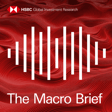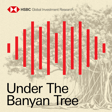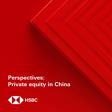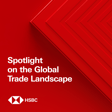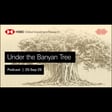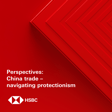Become a Creator today!Start creating today - Share your story with the world!
Start for free
00:00:00
00:00:01

Under the Banyan Tree – Asia buys Asia
It’s a studio full of equity strategists as Herald is joined by Prerna Garg and Adam Qi to discuss the ever-growing numbers of Asian investors buying up stocks in the region, and why is now an important time for this trend to continue.
Disclaimer: https://www.research.hsbc.com/R/101/lwPtFxq
Stay connected and access free to view reports and videos from HSBC Global Investment Research, just search for #HSBCResearch on LinkedIn or click here: https://www.gbm.hsbc.com/insights/global-research.
Transcript
Introduction to Global Business Insights
00:00:01
Speaker
Welcome to HSBC Global Viewpoint, the podcast series that brings together business leaders and industry experts to explore the latest global insights, trends, and opportunities.
00:00:13
Speaker
Make sure you're subscribed to stay up to date with new episodes. Thanks for listening, and now onto today's show.
Focus on Asian Equity Strategies
00:00:33
Speaker
Hello and welcome to Under the Banyan Tree where we put Asian markets and economics in context, although I must admit it's actually a little more markets than economics today because we've got three equity strategies around the table and that's definitely a first.
00:00:47
Speaker
My guests today Pran Agar and Adam Chee. We're here to talk about the growing trend of domestic equity sales in Asia. How much of your savings actually is instead of going through the banks, it goes to the equity market, then to companies that need it to invest.
00:01:02
Speaker
We're going to be focusing on two of Asia's key economies. And I think there's a very important reason to talk about this at this particular moment in time. So there's lots to get through. Let's kick off the conversation under the banyan tree.
00:01:23
Speaker
So I'd like to get into the reads on this ah Asia by Asia theme. Pruna, as always, you've looked at the numbers. What have you seen?
Growth of Asset Management in Asia
00:01:31
Speaker
So Haral, the total asset managed in Asia, that is the asset managed by pension funds, insurance companies, mutual funds, that's $22 trillion US dollar in size as of today.
00:01:44
Speaker
When we looked at it back in 2012, that was like 13 years back, this was $5 trillion US dollar in size. That's more than four times, that's grown by like 12% at an annual rate. At average rate, yeah.
00:01:55
Speaker
This is more than what we anticipated would happen at that time. So there is a lot of wealth in the region that is slowly coming into equity market. And the size is only expected to grow as the region ages.
US Dollar's Role and Impact on Asia
00:02:10
Speaker
But Haral, why is it important? Why are we talking about it today? I think when we started off looking at this ah in 2012, we were thinking about it, this is important because people saved in jewelry, for example, in India, right?
00:02:24
Speaker
hey and they're going to put in stock markets, good for the stock markets. That's absolutely right. But I think it has a sense of new urgency now because... The way the US is looking at itself, the Americans, is that they want to change the role of the dollar.
00:02:39
Speaker
They believe that the strong dollar, dollar as a reserve currency, is something that is a burden to them. And there's talk about them discouraging holding dollars. That might mean that the Americans, the US, as a provider of dollars into the world, at some point in time, that they say, we don't want to do this anymore.
00:02:57
Speaker
And Asian markets have been big buyers of this US dollar. Exactly. We're very dependent on this. so You have companies that borrow in it. People invested in it. So if at some point in time there will be sort of a dollar shortage, could be in a crisis or whatever, you need to prepare yourself for that.
00:03:11
Speaker
And that means you want to localize your markets. You want to have more local savings going into local investments. And what a better way to do that than through the equity markets. So we see that's happening and this is good for equity market over the
Investment Preferences: Asia vs. US
00:03:24
Speaker
long term. yeah But I would say like, you know, even though a large part of money from households, from individual investors has come into equity market in last 13 years, the Asian households are still under invested in equities. Yes.
00:03:37
Speaker
To put this in perspective, only 10% of the financial assets for a typical household, Chinese household, is into equities, be it in form of direct single stocks. 10%, right? ten person 10%. The same in US is 45%. So US households tend to invest much more in equities than what happens in Asia. The US is a bit of an outlier here because I suspect in Europe it would be lower, although they do a lot through the pension programs over there. But but it's right.
00:04:04
Speaker
In general, Asian households, although they have put so much money already into equities, as you said, from $5 to $22 trillion, the vast majority of money they still have in either cash or in jewelry or so stuff like that.
00:04:16
Speaker
So it's time
Trends in Chinese Household Investments
00:04:17
Speaker
to bring in Adam. Adam, welcome to ah Under the Banyan Tree podcast. I believe it's your first time it is here with us in the room. So Pranad just mentioned that Chinese households have about 10% of their wealth in in in stocks.
00:04:29
Speaker
It's been growing there, I believe. Can you tell us something about that? And secondly, how do Chinese households invest? Is it insurance? Is it pensions? Is mutual funds? Buy their own stocks? what What's the the trend? So usually, yeah if you look at the split, it's more towards mutual funds, so collective ah investments. Of course, retail investors can go ahead and open a brokerage account and invest in stocks themselves.
00:04:50
Speaker
But a lot of these retail investors just simply, they don't want to put in the time to do day trade or to analyze stocks. So they just simply buy a really good index funds and gain exposure to equity market this way.
00:05:00
Speaker
But they're still sitting on a lot of cash and that's coming into the market, right? Chinese households are sitting on around $22 trillion U.S. worth of cash. So that's a lot of cash. That's a lot of cash, yeah.
00:05:12
Speaker
And we estimated that since 2019, 2020, because people are really conservative on buying homes, buying real estates, and investing in equities, there's around $7 trillion U.S. dollars in excess saving they can potentially deploy in investments elsewhere. And, of course, one of them can be in the equity market. And they're buying eight shares at the moment. Of course, yeah. The eight sharing flows year to day from the beginning of this year to now is north of 120 billion U.S. dollars net inflow. So 22 trillion seems to be the magical number here because 22 trillion is the amount of cash that Chinese households still hold in banks.
00:05:48
Speaker
And 22 trillion is also the total size of the whole region's asset management business. by frank keyco So it's incredible. It means actually the whole region's asset management industry could double in size if the Chinese just put it all into regional funds. so It's remarkable these ah big numbers. and That's 44 trillion in total.
00:06:04
Speaker
That's like half the world's size of all equity markets. We're talking about really big numbers here.
Policy Reforms Encouraging Equity Investment
00:06:10
Speaker
Question to you, Adam. What has the Chinese government done to stimulate actually households to yeah to put money at work?
00:06:17
Speaker
On the policy side, ah they really try to ah step up on how funds are investing in equity markets pretty much since April of last year when you remember the onshore markets are pretty depressed at the time in terms of sentiments.
00:06:29
Speaker
So they're they're trying to encourage through policies so ah these funds to be quote-unquote patient capitals to to get more exposure to the equity market, long-term exposure to the equity markets. And ah Following that, we see a slew of ah policy directions, especially recently for insurance funds.
00:06:48
Speaker
ah So they dictate that ah for state-owned large insurance company, at least 30% of the new insurance premium received will be allocated into the local equity equity markets. Okay, good. So the the story is that Asia as a region needs to be self-reliant, self-funded, if you want to put like that.
00:07:07
Speaker
We need to mobilize, therefore, the savings in the regions into investment so they were not dependent on other regions, in particular shifts in geopolitics in the world. That's quite important.
00:07:18
Speaker
We see that this is happening. China is saying, hey, insurance companies, you need to put more money into equities and so There's a lot of cash that could still all help that helps support some markets. But I'd like to take a break now and then come back and look at India because I think we can learn lessons for how India has been incredibly successful in getting people to buy stocks in their own market, right?
00:07:37
Speaker
Let's do that, yeah.
00:07:47
Speaker
So we're back and we're gonna shift focus to India. Prana, 10, 15 years ago, the talk was Indians don't really invest too much in stocks because they like jewelry and there was a cultural thing, property, Indians only want jewelry and property.
00:08:00
Speaker
Turns out they are massive buyers of stocks to such an extent that that is now the biggest driver of the Indian stock market. And I think we can learn lessons from how India has done this. So the question is, how they done this? So, Harold, it's a little different from what mainland China did that Adam just mentioned about the reforms in China were more focused on the supply side, wherein the government encouraged insurance companies and mutual funds equities.
00:08:25
Speaker
ah In India, the reforms have been more on the demand side, create more demand for equity products. So that people want to invest in this? So make people... how have they done that? So there's this instrument which is called SIP, Systematic Investment Plan. That became a big hit in India. This ah SIP as a plan was introduced in late 90s, but it picked a lot of momentum only starting 2013-14. So what it happens is it's just a way via which individuals invest in mutual funds. But instead of putting a lump sum money in one go,
00:08:58
Speaker
You sign up for the plan and say every month a fixed amount would be deducted from your bank account and that go that goes into equity plans. Why was it a big hit? It's because the government or the regulators made it super easy for people to buy SIPs.
00:09:13
Speaker
The starting amount, the minimum amount you need to start an SIP is just 500 rupees. That's close to 6 US dollar. So by making it very small starting amount, they were able to encourage a lot of people to invest in equities, even the people who were not able to put aside a lump sum cash. yeah The second thing is they made these SIPs extremely popular by... Tax advantages. Tax advantages, yeah. And a lot of advertisements were made around Education. Investor education.
00:09:41
Speaker
So in the last 10 years, we've seen that these SIPs or the flows into mutual funds have become a big driver of equity market. Every month, close to $3 billion u s dollars goes into Indian market just via this mode.
00:09:54
Speaker
And what also worked in India's favor was Indian markets have given very strong returns over long term. And this just increased investors' confidence to put their money into equity markets. Yeah.
00:10:04
Speaker
So that's something that we need to see then maybe in other parts of the region as well. I think, Adam, I believe you once mentioned to me that Indonesia growth in pension funds, right? Because people move in.
Pension Fund Growth in Indonesia
00:10:15
Speaker
Yeah, exactly. So as younger workforces move into formal economy, there is naturally a demand for whether that's public or private pension funds, whether it's mandated by the government or corporates just simply up. Yeah, because they had informal job selling, let's say, cigarettes on the side of the road, and now they work.
00:10:31
Speaker
in a company, they do something and automatically you get that pension fund yeah and you start to put money into the markets. I think um these are some really key lessons. We have a formalization of jobs, we have education, tax breaks that the governments could think of.
00:10:47
Speaker
You could then also mandate companies and and these asset managers, hey, you need to put more money into stock markets to create that confidence. And I think, as I said in the very beginning, I think this is really important that Asia does this at the moment because we are very dependent on dollar funding and that needs to probably change over the course of the next years or decades.
00:11:08
Speaker
So um it's important that these policies are being enacted on so that the region is more resilient in more turbulent times in the in the future.
Conclusion and Upcoming Events
00:11:16
Speaker
That has been incredibly insightful.
00:11:18
Speaker
Prun and Adam, thank you very much for coming on to the Under the Banyan Tree podcast today. Thanks for having us, Elliot. Thank you. Under the Banyan Tree is an HSBC Global Investment Research production. Be sure to listen, like and subscribe wherever you get your podcasts.
00:11:33
Speaker
And for those of you who are in and around Greater China, we hope to see you at our upcoming China conference on the 1st and 2nd of September in Shenzhen. From all of us here in Hong Kong, take care and we'll be back next week.
00:12:12
Speaker
Thank you for joining us at HSBC Global Viewpoint. We hope you enjoyed the discussion. Make sure you're subscribed to stay up to date with new episodes.

